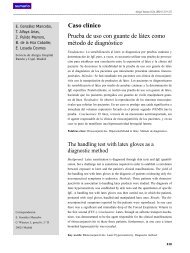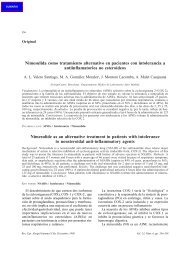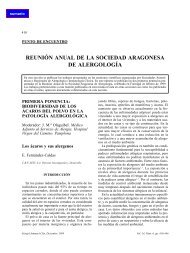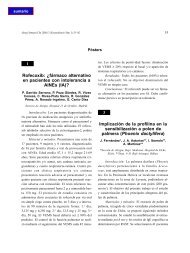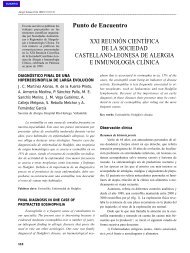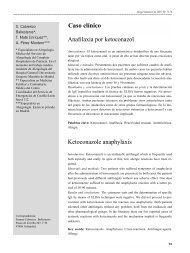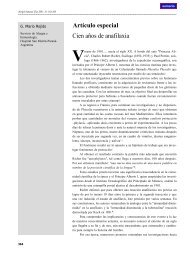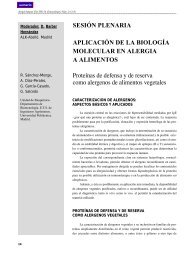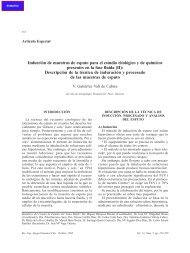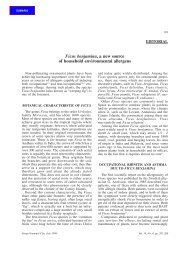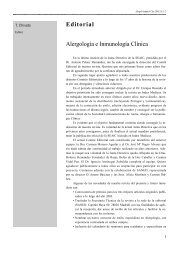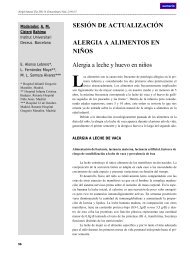Antihistamines: a review
Antihistamines: a review
Antihistamines: a review
Create successful ePaper yourself
Turn your PDF publications into a flip-book with our unique Google optimized e-Paper software.
300<br />
REVIEW ARTICLE<br />
The chemical compound §-imidazole-ethylamine<br />
was first synthesised in 1907. It was later given<br />
the name "histamine" (meaning "an amine present<br />
in all tissues") 1 , and its role in allergy and inflammation<br />
was discovered shortly thereafter. The first<br />
antihistamines to be used in medical therapy (fenbenzamine<br />
and pirylamine) were developed<br />
during the '30s at the Pasteur Institute. In 1946,<br />
two further drugs were independently discovered<br />
in the U.S.A.: diphenhydramine and tripelennamine<br />
2 . Since that time, literally hundreds of molecules<br />
with antihistamine properties have been<br />
developed, and their use in clinical therapy has<br />
incessantly grown throughout the past 50 years.<br />
The classical antihistamines have always been<br />
associated with sedation and anticholinergic<br />
effects. Since the '80s research has attempted to<br />
avoid or prevent these unwanted side effects<br />
through the investigation and development of new<br />
active principles. Over the last decade, some of<br />
these new compounds have been shown to be<br />
associated to important drug interactions and<br />
potential toxicity.<br />
The aim of the present <strong>review</strong> is to provide a<br />
bibliographic summary on the clinical pharmacology<br />
of the main antihistamines, their safety profiles<br />
and their place in the therapeutic armamentarium<br />
for the management of allergic diseases.<br />
HISTAMINE AND ITS RECEPTORS<br />
Histamine is a chemical mediator participating<br />
in many cell physiology processes, among them<br />
H1 <strong>Antihistamines</strong>: a <strong>review</strong><br />
I. J‡uregui Presa<br />
Allergy Unit, Basurto Hospital, Bilbao, Spain<br />
allergic reactions, inflammation gastric acid secretion<br />
and -probably- central and peripheral neurotransmission<br />
3 . It exerts its effects through three<br />
distinct types of postsynaptic receptors.<br />
H1 receptors. These receptors may be identified<br />
in the bronchial and gastrointestinal smooth muscle<br />
and in the brain. They are responsible for the<br />
constriction of the bronchial and vascular smooth<br />
muscle, for the activation of the afferent vagal<br />
nerves of the airways and of the cough receptors,<br />
for the increase in vascular permeability, for the<br />
local irritative manifestations such as pruritus and<br />
pain, and for the release of inflammatory mediators<br />
and the recruitment of inflammatory cells 4 .<br />
H2 receptors. These are present in the gastric<br />
mucosa, in the uterus and in the brain. They also<br />
increase vascular permeability, and they stimulate<br />
the gastric acid secretion 4 .<br />
H3 receptors. These may be found in the brain<br />
and in the bronchial smooth muscle. They are responsible<br />
for cerebral vasodilation and might be<br />
involved in the negative feedback system through<br />
which histamine inhibits its own synthesis and<br />
release from the nerve endings 3 . The main efforts<br />
in the investigation of antihistamine have been<br />
directed at the specific inhibitors of the H1 and H2<br />
receptors. The H3 antagonists, currently in the<br />
phase of animal experimentation, might find their<br />
use in the therapy of various processes affecting<br />
the central nervous system (CNS) 5 . The present<br />
<strong>review</strong> will be centred exclusively on the antagonists<br />
of the H1 receptors, which in pharmacological<br />
usage receive the generic denomination of<br />
antihistamines.<br />
Alergol Inmunol Clin, October 1999 Vol. 14, No. 5, pp. 300-312
No. 5 H1 <strong>Antihistamines</strong>: a <strong>review</strong> 301<br />
CHEMISTRY OF THE ANTIHISTAMINES<br />
The typical antihistamines have an ethylamine<br />
side chain (similar to that of histamine itself)<br />
which is united to one or more cyclic groups. The<br />
structural characteristics of the H1 receptor antagonists<br />
have been historically used for classifying<br />
them into six broad chemical families: ethanolamines,<br />
ethylenediamines, alkylamines, phenothiazines,<br />
piperazines and piperidines (Table I) 6 .<br />
Several of the new H1 receptor antagonists are<br />
chemically speaking piperidines, or at least they<br />
possess piperidine rings (Fig. 1). Many of them<br />
are direct derivatives of the parent compound or<br />
active metabolites of the primary molecules (such<br />
as cetirizine from hydroxyzine, or fexofenadine<br />
from terfenadine) 6 .<br />
Generally, the molecular nucleus of the H1 receptor<br />
antagonists is necessary for their H1 affinity and<br />
selectivity, while the side chains or radicals influence<br />
other properties of the molecules. As an example,<br />
the first-generation antihistamines contain aromatic<br />
rings and alkyl substituents which render them<br />
lipophyllic, thus explaining their ability to cross the<br />
haemato-encephalic barrier (HEB) 7 . Efforts have<br />
been directed at suppressing or preventing this property<br />
by adding or eliminating radicals in the molecular<br />
structure; thus, terfenadine requires its phenylbutanol<br />
structure in order not to cross the HEB 4,8 ,<br />
and loratadine has a carboxyethyl ester radical which<br />
limits its distribution in the CNS 9 .<br />
The ethylamine group, which is common to all<br />
typical antihistamines, is also shared by many anticholinergic<br />
and adrenergic blocking compounds.<br />
For this reason, these compounds have antidopaminergic,<br />
antiserotoninergic and antimuscarinic<br />
effects, which in many patients become undesirable<br />
side effects. They have, however, also been taken<br />
advantage of for therapeutic purposes: the antiemetic<br />
and antikinetotic actions of many antihistamines<br />
(diphenhydramine, dimenhydrinate, phenothiazines)<br />
are predominantly due to their central sedative<br />
and anticholinergic properties 9 . Some antihistamines,<br />
such as cyproheptadine, ketotifen, astemizole<br />
and cetirizine also induce increased appetite, which<br />
has been ascribed to an antiserotoninergic action 9 .<br />
This undesired side effect, which is well documented<br />
particularly in the case of cyproheptadine, has<br />
been often taken advantage of in "reconstituents"<br />
and preparations for the treatment of hypo-orexia 10 .<br />
Table I. Chemical classification of the H1 antihistamines<br />
Chemical group Typical compounds Second-generation<br />
(first generation) compounds<br />
Alkylamines Bromphenyramine Acrivastine<br />
Chlorphenyramine<br />
Triprolidine<br />
Ethanolamines Diphenhydramine<br />
Dimenhydrinate<br />
Doxylamine<br />
Carbinoxamine<br />
Clemastine<br />
Ethylenediamines Pirylamine<br />
Tripelennamine<br />
Antazoline<br />
Phenothiazines Promethazine Mequitazine<br />
Piperazines Buclyzine, Ciclyzine<br />
Cinarizine, Flunarizine Oxatomide<br />
Hydroxyzine Cetirizine<br />
Piperidines Azatadine Loratadine<br />
Cyproheptadine Astemizole<br />
Ketotifen Levocabastine<br />
Mizolastine<br />
Ebastine<br />
Terfenadine<br />
Fexofenadine<br />
Miscellany Azelastine<br />
(ftalazinone<br />
derivative)<br />
MECHANISMS OF ACTION<br />
The antihistamines behave as competitive antagonists<br />
of histamine: they bind to the H1 receptor<br />
without activating it, and thus prevent histamine<br />
from binding to and activating this receptor. The<br />
binding of many antihistamines is readily reversible<br />
but some of them, such as terfenadine and<br />
astemizole, are not easily dissociated from their<br />
binding to the receptors 11 . Even though there are<br />
some specific molecules for which such effects<br />
have been documented, antihistamines as a group<br />
do not chemically inactivate histamine, nor do<br />
they antagonise it in a physiological sense, nor do<br />
they in any manner prevent its release 9 .<br />
Many recent studies suggest that some H1<br />
receptor antagonists might also have antiinflammatory<br />
or antiallergic properties in the broadest<br />
sense of those concepts. Although the first publication<br />
in this context referred to azatadine 12 , this<br />
type of additional actions has been later attributed<br />
to many second-generation antihistamines.
302 I. J‡uregui Presa Volume 14<br />
Cetirizine 13,14 reduces the attraction of inflammatory<br />
cells to the inflammatory focus after antigen<br />
challenge and inhibits the expression of the intercellular<br />
adhesion molecule 1 (ICAM-1) on the surface<br />
of epithelial cells. It also might be able to block the<br />
antigen-induced production of leukotrienes (LTC 4) 15 .<br />
Loratadine and its metabolite decarboethoxyloratadine<br />
inhibit the release of tryptase and amacroglobulin<br />
16 , of interleukins (IL) 6 and 8 17 and<br />
of leukotrienes and prostaglandin D2 (PGD2) 18 , and<br />
also the expression of ICAM-1 and of HLA-II<br />
antigens on the surface of epithelial cells 19 .<br />
Terfenadine inhibits the inflammatory cellular<br />
infiltrate and the eosinophil activation products in<br />
nasal lavage fluid and also the expression of surface<br />
ICAM-1 20 . It may also inhibit the release of leukotrienes<br />
from basophils and eosinophils and of<br />
histamine from basophils, as well as inhibiting skin<br />
reactivity to the platelet activation factor (PAF) 15 .<br />
Topical azelastine, which was initially studied as<br />
a "dual action" antihistamine with a clinical profile<br />
similar to that of ketotifen or oxatomide 2 , also seems<br />
to inhibit the eosinophyllic infiltrate and the expression<br />
of surface ICAM-1 in nasal epithelial cells 21 .<br />
Ebastine might have an antagonist action on the<br />
IgE-induced release of PGD2 and LTC 4/D 4 22 .<br />
A recent study in a rat model ascribes to mizolastine<br />
an antiinflammatory effect on the skin<br />
reaction induced by arachidonic acid 23 .<br />
Finally, fexofenadine inhibits the spontaneous<br />
release of IL-6 in fibroblast cultures 24 and the<br />
eosinophil-induced release of IL-8 and GM-CSF,<br />
as well as the expression of surface ICAM-1 in<br />
cultures of nasal epithelial cells.<br />
These antiinflammatory effects of antihistamines<br />
are not considered to be linked to H 1 receptor blockage.<br />
As they have mostly been demonstrated in<br />
vitro and with experimental concentrations of the<br />
drugs that are much higher than those achieved in<br />
vivo with the usual pharmacological dosages, their<br />
relative importance within the overall spectrum of<br />
the clinical efficacy of these drugs is still unknown 15 .<br />
PHARMACOKINETICS AND<br />
PHARMACODYNAMICS<br />
Almost all the H1 receptor antagonists have<br />
adequate oral absorption and can achieve maximal<br />
plasma concentrations within the 24 hours follo-<br />
Cl<br />
HN<br />
N<br />
HISTAMINA<br />
HISTAMINE<br />
CH 2 CH 2 NH 2<br />
CHLORPHENYRAMINE<br />
CLORFENIRAMINA<br />
N<br />
PRIMERA FIRST-GENERATION GENERACIîN DE ANTAGONISTAS H1 RECEPTOR ANTAGONISTS<br />
DE RECEPTORES H1<br />
Cl<br />
CH CH 2 CH 2<br />
CH O CH 2<br />
CH 2<br />
DIPHENHYDRAMINE<br />
DIFENHIDRAMINA<br />
Fig. 1a. Primary structure of histamine and of various H1<br />
antihistamines.<br />
wing administration. Most of the second-generation<br />
antihistamines, with the exception of acrivastine,<br />
cetirizine, levocabastine, fexofenadine and<br />
perhaps some other active metabolites experience<br />
hepatic first-pass metabolism, so that the plasma<br />
concentrations of the parent drugs are usually<br />
indetectable a few hours after administration 26 .<br />
Nevertheless, the effects of the antihistamines, as<br />
documented in studies of inhibition of histamineinduced<br />
skin reactions, persist over a time that is<br />
variable for each compound (Table II). This might<br />
be due to a greater tissue concentration, or to active<br />
metabolites maintaining the effect 27 .<br />
Because all the H1 receptor antagonists inhibit<br />
the skin reactions induced by histamine, this test<br />
has become a standardised biologic test for the<br />
action of antihistamines 15 . However, as several<br />
authors have pointed out 28 , there is not always a<br />
N<br />
OH N N CH2CH2 O CH2CH2 O<br />
H<br />
N<br />
CH 3<br />
CH 3<br />
CH 3<br />
CH 3<br />
HIDROXICINA<br />
HYDROXYZINE
No. 5 H1 <strong>Antihistamines</strong>: a <strong>review</strong> 303<br />
HO N<br />
CH 3<br />
N<br />
CH CH<br />
N<br />
C CH CH 2<br />
ACRIVASTINE<br />
ACRIVASTINA<br />
CH 2 CH 2 CH 2 CH C<br />
TERFENADINA<br />
TERFENADINE<br />
O<br />
LORATADINA<br />
LORATADINE<br />
SEGUNDA SECOND-GENERATION GENERACIîN DE ANTAGONISTAS H1 RECEPTOR ANTAGONISTS<br />
DE RECEPTORES H1 Fig. 1b. Primary structure of histamine and of various H1 antihistamines.<br />
correlation between the degree of inhibition of the<br />
skin response and the clinical efficacy of the<br />
various drugs.<br />
All the "classical" antihistamines and also many<br />
of the second-generation ones (terfenadine 29 , ebastine<br />
30 , astemizole 31 , loratadine 26 , mizolastine 32 ) are<br />
metabolised to a greater or lesser extent by the<br />
hepatic cytochrome p-450 system (CYP), a fact of<br />
utmost importance in the development of drug interactions<br />
and drug toxicity. The CYP is an enzymatic<br />
system responsible for drug metabolism and<br />
detoxification present in the liver and in other tissues,<br />
and its constituent isoenzymes are classified<br />
into "families" according to the similarity of their<br />
aminoacid sequences 33 . As a result of genetic variability,<br />
the number of p-450 isoenzymes varies, and<br />
each drug is metabolised in a different manner 15 .<br />
Astemizole or terfenadine are metabolised by the<br />
3A4 family (CYP3A4). Within this same family,<br />
some substances can behave as enzymatic inhibitors<br />
while others act as enzyme substrates, and this<br />
OH<br />
N C O CH2CH2 O<br />
C OH<br />
HO N CH 2 CH 2 CH 2 C<br />
Q<br />
Q HCl<br />
N<br />
OH<br />
FEXOFENADINE<br />
FEXOFENADINA<br />
CH 3<br />
C<br />
CH 3<br />
CH 3<br />
CH 3<br />
CH 3<br />
COOH<br />
CH 2<br />
O<br />
AZELASTINE<br />
AZELASTINA<br />
N<br />
N<br />
N<br />
Cl<br />
CH N N CH2 CH2 O CH2 C OH<br />
CH 3<br />
ASTEMIZOLE<br />
ASTEMIZOL<br />
LEVOCABASTINE<br />
LEVOCABASTINA<br />
HC O<br />
N CH2 CH2 CH2 C C<br />
HC O<br />
EBASTINE<br />
EBASTINA<br />
N CH 2 CH 2 CH 2 C C<br />
CAREBASTINE<br />
CAREBASTINA<br />
F<br />
NC<br />
gives rise to multiple interactions 33 . Table III summarises<br />
some inhibitors and substrates of the<br />
CYP3A4. It should be noted that natural flavonoids<br />
present in grape juice may also inhibit the 3A4<br />
family 33,34 and that erythromycin is at the same time<br />
inhibitor and substrate for the CYP3A4 33 .<br />
On the other hand, erythromycin is by itself<br />
able to block some potassium channels in the<br />
myocardium 35 . This might be fundamental, as will<br />
be explained later, in its interactions with some<br />
antihistamines.<br />
SIDE EFFECTS ON THE<br />
CARDIOVASCULAR SYSTEM<br />
The potential cardiotoxicity of antihistamines<br />
was first reported in relation with astemizole 36 and<br />
later with terfenadine 37 . Considerable attention was<br />
focused on the latter drug, however, possibly because<br />
it was the most widely used one in the USA 38 .<br />
O<br />
N<br />
H<br />
O<br />
H<br />
CH 3<br />
CH 3<br />
CH 3<br />
CH 3<br />
CH 3<br />
O<br />
O<br />
C OH<br />
CH 3<br />
COOH
304 I. J‡uregui Presa Volume 14<br />
Table II. Chemical classification of the H1 antihistamines 15,24,26<br />
Drug Dose Plasma elimination Skin test Protein binding Clearance<br />
(mg/day) half-life suppression (%) (ml á min -1 á kg -1 )<br />
Acrivastine 16 - 24 ~2 hours 8 hours 50 4.41<br />
Astemizole 10 - 20 12 - 20 days 6 - 8 weeks 97 11.0<br />
Azelastine (oral) 4 - 8 22 - 42 hours 1 week 77 - 88 8.45<br />
Bromphenyramine 9 - 18 24.9 hours 3 - 9 hours<br />
Chlorphenyramine 6 - 12 24.2 hours 24 hours<br />
Clemastine 2 - 3 7 - 12 hours 10 - 24 hours<br />
Cetirizine 10 7 - 10 hours 24 - 72 hours 93 - 98 0.8<br />
Hydroxyzine 75 20 hours 2 - 36 hours<br />
Ebastine 10 15 hours 28 hours 97.7 1.3 - 2.0<br />
Levocabastine<br />
Nasal spray 0.6 35 - 40 hours 10 - 12 hours 55 0.43<br />
Eye drops 0.2 35 - 40 hours 4 hours<br />
Loratadine 10 8 - 24 hours 12 - 14 hours 97 - 99 ?<br />
Mizolastine 10 14.5 hours 24 hours 1.15<br />
Noberastine 10 15 hours 32 - 72 hours<br />
Terfenadine 120 17 hours 24 - 72 hours 97 8.8<br />
Fexofenadine 120 - 180 14.4 hours 24 - 72 hours<br />
The reported arrhythmia associated to astemizole<br />
and terfenadine is a polymorphic ventricular tachycardia<br />
known by the name of torsades de pointes<br />
because of its changing electrical axis in the ECG,<br />
with waves of alternating amplitudes and directions<br />
(Figure 2). Torsades de pointes may appear as acute<br />
episodes with haemodynamic compromise and<br />
even sudden cardiac death 39 and are associated to a<br />
lengthening of the QT interval in the sinus rhythm<br />
ECG. The QT interval itself depends on the duration<br />
of the cardiac action potential, which is in its<br />
turn dependent on the ionic currents and fluxes in<br />
the myocardium and most particularly on the socalled<br />
potassium rectifier channel 40 .<br />
As already pointed out, terfenadine is a prodrug<br />
acting through its acid metabolite (terfenadine<br />
carboxylate, or fexofenadine), and this conversion<br />
occurs through a CYP3A4-dependent hepatic<br />
first-pass metabolism. Terfenadine is a potent<br />
blocker of the potassium rectifier channel 41 . Its<br />
accumulation in the organism because of overdosage<br />
or of the concomitant administration of other<br />
substrate drugs or CYP3A4 inhibitors may lengthen<br />
the heart rate-corrected QT interval (QTc). If<br />
the concomitant drug is erythromycin, which is at<br />
the same time a CYP3A4 substrate and a<br />
CYP3A4 inhibitor 33 and also a potassium rectifier<br />
channel blocker 35 , the heart repolarisation derangements<br />
will be even more marked.<br />
This effect might perhaps be shared by all the<br />
piperidine antihistamines 42 , but it has been<br />
demonstrated mainly with astemizole, terfenadine<br />
and ebastine 43 at a dosage one- to fourfold the respective<br />
peripheral antihistamine one although not<br />
with the active metabolites fexofenadine and carebastine,<br />
in experimental models 44,45 . Nevertheless,<br />
an isolated clinical observation has been published<br />
of torsades de pointes and lengthened QT<br />
interval in a patient with indetectable levels of<br />
astemizole and "therapeutic" concentrations of its<br />
major metabolite demethyl-astemizole 46 .<br />
Cetirizine, an active metabolite of hydroxyzine,<br />
does not prolong the QTc interval at dosages up to<br />
sixfold the indicated therapeutic ones 47 . Loratadine<br />
has the same interactions with macrolides and<br />
imidazoles as the other piperidines, yet this does<br />
not induce clinically significant changes in the<br />
QTc interval 48,49 . It has been reported that loratadine,<br />
contrary to astemizole, terfenadine and ebastine,<br />
does not block the potassium channels even at<br />
concentrations 100-fold its normal plasma level 50 .<br />
Even so, and according to WHO drug surveillance<br />
data, loratadine and cetirizine have also been<br />
associated, though much less frequently than terfenadine<br />
or astemizole, to reports of sudden or<br />
cardiac death 51 . There are also recent experimental<br />
studies suggesting that loratadine might be able to<br />
block certain potassium channels 52 .
No. 5 H1 <strong>Antihistamines</strong>: a <strong>review</strong> 305<br />
Table III. Inhibitors of the 3A4 family of cytochrome P-450<br />
(CYP3A4)<br />
Enzymatic inhibitors<br />
Cimetidine, Ranitidine<br />
Clarythromycine, Erythromycine, Troleandomycine (TAO)<br />
Ketoconazole, Itraconazole<br />
Fluvoxamine, Norfluoxetine (a metabolite of fluoxetine)<br />
Natural flavonoids in grape juice<br />
Enzymatic substrates<br />
Astemizole, Terfenadine, Ebastine, Loratadine, Mizolastine<br />
Cisapride<br />
Erythromycin<br />
A number of added risk factors for the development<br />
of torsades de pointes in patients under treatment<br />
with antihistamines have been considered,<br />
such as previous hepatic dysfunction, hypokaliaemia,<br />
hypomagnesaemia, bradycardia situations and<br />
the congenital long QT syndrome (Table IV) 33,40 .<br />
Even though these side effects have not been as<br />
intensively investigated for other H1 antagonists, a<br />
quinidine-like effect on myocardial conduction has<br />
been described for antihistamines as a group 9. A<br />
cohort study actually demonstrated a greater incidence<br />
of ventricular arrhythmias and cardiac arrest<br />
in the group of patients receiving O.T.C. antihistamines<br />
as compared to the groups receiving terfenadine<br />
or clemastine 53 . However, other studies have<br />
not evidenced actions on cardiac electrophysiology<br />
for chlorphenyramine or pirylamine, suggesting<br />
that this may be a piperidine effect or a specific one<br />
of astemizole, terfenadine and ebastine 54 .<br />
The initial worry that cardiotoxicity might<br />
represent a class effect of the antihistamines,<br />
however, appears to be unfounded 38 considering<br />
that fexofenadine (with negligible hepatic metabolism<br />
24 ) and probably further active metabolites<br />
with potent H 1-antagonist action 45 are devoid of<br />
this adverse effect. Whatever the case may be, it<br />
appears to be important to keep in mind all the<br />
factors already pointed out (Table IV) when prescribing<br />
antihistamines in clinical practise.<br />
ANTIHISTAMINES IN BRONCHIAL ASTHMA<br />
There is a long-standing belief that antihistamines<br />
may be harmful in asthmatic patients because<br />
Table IV. Risk factors for ventricular arrhythmias in patients<br />
receiving antihistamines 33,40<br />
1. Coadministration of other drugs<br />
a. Agents which prolong the QT interval, such as quinidine<br />
or erythromycin<br />
b. Enzymatic substrates/inhibitors of CYP3A4 (Table III)<br />
2. Preexistent liver disease<br />
3. Electrolyte balance derangements<br />
a. Hypokaliemia<br />
b. Hypomagnesemia<br />
4. Congenital long QT syndrome<br />
5. Bradycardia situations<br />
of the mucosal dryness effect of the anticholinergic<br />
action of the initial preparations to which the<br />
induction of bronchial asthma in children was<br />
ascribed 55 . However, and considering that histamine<br />
causes bronchial constriction and oedema, it<br />
appears to be logical to think that antihistamines<br />
might revert some of its effects on the bronchial<br />
tree, and that they are not contraindicated in asthmatic<br />
patients 56 . In this context, there is ample<br />
experience in Spain with ketotifen, and a number<br />
of studies suggest that azelastine, cetirizine, loratadine,<br />
terfenadine and astemizole might at least<br />
block the bronchospasm induced by histamine 57 .<br />
In any case, the effects of histamine in the latephase<br />
reaction have not been fully clarified and<br />
further studies are warranted for defining the<br />
effects of H1 antagonism in this late phase, particularly<br />
in the case of the antihistamines with additional<br />
antiinflammatory properties 15 .<br />
As the aim of the present <strong>review</strong> is to try to<br />
define the place of the principal antihistamines in<br />
the therapeutic armamentarium, a brief chemical<br />
and therapeutic discussion of the main H1 antihistamines<br />
currently used in Spain follows as a conclusion.<br />
"CLASSICAL" H1 ANTIHISTAMINES<br />
Chlorphenyramine and dextrochlorphenyramine.<br />
The prototypes of the alkylamines (propylamines),<br />
chlorphenyramine and its isomer dextrochlorphenyramine<br />
are used in a host of O.T.C.<br />
"anticatarrhal" preparations, usually in associations<br />
with vasoconstrictors, expectorants and analgesics.<br />
Dexchlorphenyramine is furthermore the<br />
only antihistamine available for parenteral use in
306 I. J‡uregui Presa Volume 14<br />
Fig. 2. Ventricular tachycardia of the "torsades de pointes" variety. Simultaneous recording of leads I, II, III and V1.<br />
our country 10 . Their plasma half-life is about 24<br />
hours, the same as the duration of the suppression<br />
of the skin test with histamine 57 (Table II). The<br />
rationale for their retarded-release formulations<br />
("Repetabs") is mainly to delay the plasma concentration<br />
peak in order to reduce the adverse<br />
CNS 4 effects representing the main problem of<br />
these drugs: at therapeutic dosages they cause<br />
somnolence, abatement of the reflexes and electroencephalographic<br />
(EEG) changes 58 .<br />
Diphenhydramine. In Spain, this drug is at present<br />
only available in some anticatarrhal associations<br />
and as an hypnotic 10 because of the intensity<br />
of its CNS effects 58 . Its derivative dimenhydrinate<br />
is widely used in our country as an antikinetotic.<br />
Clemastine. This is the prototype of the ethanolamines,<br />
the same chemical family as diphenhydramine,<br />
in Spain. It is currently available only<br />
for oral administration 10 . Its plasma half-life is 7-<br />
12 hours, with a skin test suppression period of<br />
12-24 hours. Its anticholinergic, antidopaminergic<br />
and antiserotoninergic affects are similar to those<br />
of the other "classical" antihistamines 9 .<br />
Cyproheptadine and azatadine. With a very<br />
close structural correlation between them, the two<br />
classical piperidines are characterised by their<br />
potent antiserotoninergic, anticholinergic and<br />
sedative effects. The first one of these effects has<br />
been taken advantage of for indications such as<br />
Cushing's syndrome, the carcinoid syndrome or<br />
vascular migraine 9 , and also in the management of<br />
hypo-orexia 10 . Azatadine is the parent compound<br />
of loratadine.<br />
Hydroxyzine. This drug has an elimination halflife<br />
of 14-20 hours in the adult and concentrates<br />
rapidly in the skin, so that sustained high skin<br />
concentrations can be observed after both single<br />
and multiple dosing; it can inhibit the response to<br />
histamine during at least 36 hours after a single<br />
dose in healthy adult subjects 4 . It is classically<br />
considered to be the most effective antihistamine<br />
for the management of pruritus 59 , an effect that is<br />
in part attributable to its potent sedative action<br />
(which has been taken advantage of for therapeutic<br />
purposes).<br />
Cinarizine and flunarizine. These classical<br />
piperazines, which are structurally different from<br />
hydroxyzine and cetirizine, have been mostly<br />
used for their antikinetotic activity. Flunarizine is<br />
the bi-fluorinated derivative of cinarizine and also<br />
has a calcium channel-blocking action 6 ; it is used<br />
for prophylaxis of migraine and vertigo and in the<br />
management of cerebral and peripheral vascular<br />
conditions.<br />
Promethazine. An ethylamine derivative of<br />
phenothiazine, this compound has the same sedative<br />
characteristics of other phenothiazine drugs,<br />
together with potent antihistamine and antikineto-
No. 5 H1 <strong>Antihistamines</strong>: a <strong>review</strong> 307<br />
tic actions 9 . During the '70s and '80s it was one of<br />
the most widely used antihistamines in our<br />
country despite its potential toxicity: it can cause<br />
blood dyscrasias, neuro- and hepatotoxicity and<br />
diverse skin reactions such as contact urticaria,<br />
systemic contact dermatitides and phototoxic and<br />
photoallergic reactions 60 .<br />
SECOND-GENERATION H 1<br />
ANTIHISTAMINES<br />
Mequitazine. A phenothiazine derivative similar<br />
to prometazine but without sedative effects at<br />
the recommended dosages; this characteristic has<br />
been attributed in principle to a greater affinity of<br />
the drug for the peripheral than for the central H1<br />
receptors 2 . Similar to other antihistamines, mequitazine<br />
has evidenced bronchodilator activity<br />
which was in this case ascribed to the calmodulininhibiting<br />
ability of phenothiazines, which would<br />
thus interfere the action of phospholipase A 2 61 .<br />
With the exception of the absence of sedation at<br />
low dosages, its adverse effects are those of phenothiazines<br />
as a group 9 .<br />
Ketotifen. A derivative of the tricyclic compound<br />
benzo-cyclo-heptathiofene, this drug has<br />
been marketed as a membrane stabiliser for the<br />
effector cells of the allergic reactions. Its pharmacologic<br />
profile is similar to that of the cromones,<br />
and it is orally active 62 . Its main action, however,<br />
is a double competitive and non-competitive inhibition<br />
of the H1 receptor 2 . It shares with other<br />
older antihistamines the sedative and antiserotoninergic<br />
effects 2,6,9 .<br />
Oxatomide. This is a piperazine and structurally<br />
and chemically very similar to the antikinetotic<br />
cinarizine. Also oxatomide was marketed as a<br />
mastocyte degranulation inhibitor 63 ; however,<br />
and similar to ketotifen, its main effects are H1<br />
antihistaminic, anticholinergic and antiserotoninergic<br />
2,64 . Recent publications from Japan stress its<br />
various antiinflammatory and antiallergic<br />
actions 65,66 .<br />
Astemizole. This molecule is metabolised by<br />
the hepatic cytochrome p-450 to demethyl-astemizole<br />
(DMA), which has significant antihistamine<br />
activity. Once oral administration is begun, stable<br />
plasma concentrations of astemizole are achieved<br />
after one week, and the plasma concentrations of<br />
astemizole plus its metabolites persist for over<br />
four weeks 31 . Astemizole has a half-life of 1.1<br />
days, and its metabolite DMA 9.5 days 4 . The suppressive<br />
effects on the skin response to histamine<br />
and the histamine-induced bronchoconstriction<br />
may persist for four to six weeks (Table II). As<br />
pointed out earlier, it is subject to the drug interactions<br />
of other antihistamines metabolised by<br />
the hepatic cytochrome p-450 and together with<br />
DMA is potentially cardiotoxic 36,46 . Astemizole<br />
has not been associated to drowsiness, but it has<br />
been associated to weight gain4.<br />
Terfenadine. This is chemically a butyrofenone<br />
derivative 29 and it is the most representative one<br />
among the non-sedative antihistamines, as it does<br />
not cross the haemato-encephalic barrier due to its<br />
phenylbutanol structure 8 . Its half-life is 16 to 24<br />
hours and, as already stated, it is a prodrug acting<br />
through its acid metabolite, terfenadine carboxylate<br />
or fexofenadine, after first-pass hepatic metabolism.<br />
Terfenadine rapidly inhibits the skin response<br />
to histamine, and this effect persists for<br />
seven days more after the withdrawal of the<br />
drug 4,29 . Its drug interactions and its cardiotoxic<br />
potential have already been discussed. In a number<br />
of studies, the side effects of terfenadine on<br />
the CNS and on the gastrointestinal tract, as well<br />
as its anticholinergic effects, have been similar to<br />
those of placebo 9 .<br />
Azelastine. This is a ftalazinone derivative and<br />
structurally unrelated to other antihistamines. It<br />
was initially investigated for oral use as an inhibitor<br />
of the mastocitary release of inflammatory<br />
mediators 67 . It is metabolised through hepatic oxidation;<br />
although it has a 22-hour half-life, its<br />
pharmacologically active major metabolite,<br />
demethyl-azelastine, has a half-life of 54 hours 68 .<br />
It is available in Spain for topical use as nasal<br />
spray and eye drops, and has demonstrated significant<br />
inhibition of the intranasal response to histamine<br />
69 and effectiveness in the control of the<br />
symptoms of rhinitis similar to that of a number<br />
of systemic antihistamines 70 . Dysgeusia, or changes<br />
in taste perception, is the most frequently<br />
reported adverse effect 4,70 .<br />
Levocabastine. This cyclohexyl-piperidine was<br />
developed for topical ocular and nasal administration.<br />
It has a 35 - 40 hour half-life and little or no<br />
systemic absorption 71 . In controlled studies it has<br />
been less effective that topical steroids 4 but at
308 I. J‡uregui Presa Volume 14<br />
least as effective as disodium cromoglycate 4 , topical<br />
azelastine 72 , terfenadine 73 or loratadine 74 in the<br />
control of the symptoms of allergic rhinoconjunctivitis.<br />
It is available as nasal sprays and eye<br />
drops.<br />
Cetirizine. This is the acid metabolite of<br />
hydroxyzine. Forty to sixty per cent of the amount<br />
administered is excreted unchanged in the urine<br />
and its elimination is reduced in renal failure 14 .<br />
Like hydroxyzine, it is rapidly concentrated in the<br />
skin. It is considered to be the most effective<br />
antihistamine, with the exception of astemizole,<br />
for the suppression of the skin response to histamine<br />
4,28 . The beginning of its action occurs one<br />
hour after administration and its peak effect is<br />
seen 4 to 8 hours after administration 14 . As previously<br />
stated, it has been attributed antiinflammatory<br />
13 and antiasthmatic 15 effects. As it is not<br />
metabolised by the CYP, it lacks the drug interactions<br />
of other compounds 26 . Cetirizine does not<br />
prolong the QTc interval at doses up to sixfold the<br />
therapeutic ones 47 . Even though in more objective<br />
studies cetirizine has no effect on the psychomotor<br />
performance at dosages up to 10 mg/day 4 , the<br />
clinical experience shows that it causes subjective<br />
drowsiness, which may be its major drawback.<br />
Loratadine. This is a piperidine with a structure<br />
similar to that of azatadine, from which it differs<br />
in the presence of a carboxyethyl radical that<br />
limits its distribution in the CNS 9 . Loratadine is a<br />
prodrug that is metabolised to a large extent by<br />
the CYP3A4 system to its active metabolite<br />
decarboethoxy-loratadine (DCL) 75 . Its half-life is<br />
8 to 11 hours, and that of DCL 17 to 23 hours. At<br />
the recommended dosages it does not cause sedation<br />
and does not have cardiovascular effects 76 .<br />
Loratadine is less effective than other piperidines<br />
in the suppression of the skin response to histamine,<br />
but this does not appear to hamper its clinical<br />
efficacy 28 . Because of its hepatic first pass metabolism,<br />
loratadine has the same drug interactions<br />
with macrolides and imidazoles as other piperidines<br />
but, as already stated, this does not cause significant<br />
changes in the QTc interval 48,49 , as it is not<br />
a potent potassium channel blocker 50 .<br />
Ebastine. Chemically this is a piperidino-butyrofenone<br />
6 , and it is structurally very similar to the<br />
terfenadine molecule (Fig. 1 b). It is also a prodrug<br />
and is metabolised by the hepatic CYP3A4<br />
system in first-pass metabolism, after which it<br />
acts through its carboxylated metabolite carebastine<br />
(or LAS-X-113), with a half-life of 10.6<br />
hours 77 . As already stated, and because they share<br />
chemical structure and metabolic pathways, ebastine<br />
has the same drug interactions as terfenadine<br />
30 . At least in theory, might also share a similar<br />
cardiotoxicity risk as it blocks the myocardial<br />
potassium rectifier channel 43 , though to a lesser<br />
degree than terfenadine 44 and its therapeutic dosage<br />
is also six times lower. Its acid metabolite carebastine<br />
is devoid of these effects and interactions<br />
44,45 . On the other hand, ebastine has been<br />
demonstrated not to have anticholinergic actions,<br />
nor does it impair the psychomotor performance<br />
at therapeutic dosages 78 .<br />
Mizolastine. Its structure is that of a piperidinebenzoimidazole<br />
derivative; it acts as a specific<br />
ligand for the H1 receptors with peak antihistamine<br />
activity four hours after administration, which<br />
is maintained for approximately 24 hours 32 . Its<br />
effectiveness in the suppression of the skin reaction<br />
to histamine is similar to that of cetirizine and<br />
terfenadine, and greater than that of loratadine 79 . It<br />
is metabolised in the liver, predominantly through<br />
glucuronisation of the original molecule and to a<br />
much lesser degree through oxidation through the<br />
CYP3A4 and CYP2A6 systems 32 , although it evidences<br />
the same interactions with imidazoles and<br />
macrolides as other piperidines 32 . As no active<br />
metabolites have been detected 80 , its pharmacologic<br />
activity appears to depend on the original<br />
compound. Mizolastine does not cause sedation at<br />
a dosage of 10 mg/day but it does so at 20<br />
mg/day 81 ; it does not appear to interact significantly<br />
with alcohol 82 , or to have anticholinergic<br />
effects 83 .<br />
Fexofenadine. This is the acid metabolite of terfenadine.<br />
As already stated, 99% of the administered<br />
dose of terfenadine undergoes first-pass<br />
hepatic metabolism to its carboxylic acid metabolite,<br />
and acts through it. Fexofenadine has a distribution<br />
phase of 2 to 4 hours and an elimination<br />
phase of 17 hours 24 , and shares the antihistamine<br />
properties and the lack of sedative and anticholinergic<br />
effects of the parent compound. However,<br />
as it undergoes practically no metabolisation in<br />
the liver 24 , it does not interact with the imidazoles<br />
or the macrolides nor, foreseeably, with other<br />
inhibitors or substrates of the cytochrome p-450.<br />
As it does not inhibit the myocardial K + chan-
No. 5 H1 <strong>Antihistamines</strong>: a <strong>review</strong> 309<br />
nels 45 , it has no effects on the QTc interval of the<br />
ECG 24,33,38 . Fexofenadine has been investigated in<br />
multiple clinical studies in allergic rhinitis and<br />
chronic urticaria at dosages of 60 mg/12 hours<br />
and at single daily doses of 120 mg, 180 mg and<br />
240 mg 24,84,85 . It has evidenced optimal efficacy<br />
and tolerability although in a number of studies<br />
there does not appear to exist a linear dose-response<br />
relationship between a given dosage and<br />
the reduction of symptoms 15 . On the basis of these<br />
clinical studies, the dosage recommended as<br />
the optimal one for adults and children over 12<br />
years is 120 mg once a day for allergic rhinitis,<br />
and 180 mg once a day for chronic urticaria 86 . On<br />
the other hand, fexofenadine does not interact<br />
with alcohol nor does it affect psychomotor performance,<br />
and preliminary studies suggest that no<br />
dose adjustment is required in the elderly nor in<br />
patients with hepatic or renal failure 24,86 .<br />
Others. There are many new H1 receptor antagonists<br />
which have not yet been marketed in Spain,<br />
such as acrivastine (a triprolidine metabolite with a<br />
very short duration of action requiring four times<br />
daily dosage 4 ), noberastine (an astemizole derivative<br />
with a faster beginning of action than the parent<br />
compound 87 ) or epinastine (an antihistamine with<br />
antiinflammatory actions studied fundamentally in<br />
Japan for use in bronchial asthma 88 ). A number of<br />
new molecules are currently under study for oral or<br />
topical administration, but it is still too early to<br />
define their eventual role.<br />
REFERENCES<br />
1. Salv‡ Miquel JA: Evoluci—n de los antihistam’nicos.<br />
JANO 1991; 1125.<br />
2. Trzeciakowski JP, Mendelsohn N, Levi R. Antihistam’nicos.<br />
En: Middleton E, et al, ed: Alergia: Principios<br />
y Pr‡ctica (ed esp) Barcelona: Salvat Editores,<br />
SA. 1992; vol. 1 cap. 31.<br />
3. Mart’nez-Mir I, Palop Larrea V, Morales-Olivas<br />
FJ. Antihistam’nicos H1. Perfil de seguridad. En:<br />
çlvarez FJ, del R’o MC. Antihistam’nicos H1 y<br />
conducci—n de veh’culos. Barcelona: Masson SA,<br />
1998.<br />
4. Simons FER. <strong>Antihistamines</strong>. En: Kaplan AP, 2nd<br />
ed. Allergy. Filadelfia: WB Saunders Co, 1997.<br />
5. Prous JR. The year's drugs news. Therapeutic targets<br />
1994. Barcelona. JR Prous Science Publishers,1994.<br />
6. Martindale. The Extra Pharmacopoeia, 31th ed.<br />
Reynolds JEF, ed. Londres. The Royal Pharmaceutical<br />
Society, 1996.<br />
7. Meltzer EO. An overview of current pharmacotherapy<br />
in perennial rhinitis. J Allergy Clin Immunol<br />
1995; 95: 1097-1110.<br />
8. Zhang MQ, Laak AM, Timmerman H. Structure -<br />
activity relationships within a series of analogues<br />
of the histamine H1-antagonist terfenadine. Eur J<br />
Med Chem 1993, 28: 165-173.<br />
9. McEvoy GK, ed. American Hospital Formulary<br />
Service (AHFS) Drug Information 1996. Bethesda:<br />
AFS, ed. 1996.<br />
10. VademŽcum Internacional Medicom, 38» ed, 1997.<br />
11. Simons FER, Simons KJ. The pharmacology and<br />
use of H1-receptor-antagonist drugs. N Engl J Med<br />
1994; 330: 1663-1670.<br />
12. Togias AG, Naclerio RM, Warner J, et al.<br />
Demonstration of inhibition of mediator release<br />
from human mast cells by azatadine base: in vivo<br />
and in vitro evaluation. JAMA 1986; 255: 225-<br />
229.<br />
13. Ciprandi G, Buscaglia S, Pesce G, Passalacqua G,<br />
Rihoux JP, Bagnasco M, et al. Cetirizine reduces<br />
inflammatory cell recruitment and ICAM-1 (or<br />
CD54) expression on conjunctival epithelium in<br />
both early and late-phase reactions after allergenspecific<br />
challenge. J Allergy Clin Immunol 1995;<br />
95: 612-621.<br />
14. An—nimo. Cetirizina - Un nuevo antihistam’nico.<br />
Med Lett Drugs Ther (ed. esp.) 1996; 18: 33-35.<br />
15. Du Buske LM. Clinical comparison of histamine<br />
H1-receptor antagonist drugs. J Allergy Clin Immunol<br />
1996; 98: S307-S318.<br />
16. Greiff L, Persson CGA, Svensson C, Enander I,<br />
Anderson M. Loratadine reduces allergen-induced<br />
mucosal output of alfa-2-macroglobulin and tryptase<br />
in allergic rhinitis. J Allergy Clin Immunol<br />
1995; 96: 97-103.<br />
17. Lippert U, Kruger-Krasagakes S, Moller A, Kiessling<br />
U, Czarnetzki BM. Pharmacological modulation<br />
of IL-6 and IL-8 secretion by H1-antagonist<br />
descarboethoxy-loratadine and dexamethasone by<br />
human mast and basophilic cell lines. Exp Dermatol<br />
1995; 4: 272-276.<br />
18. Bousquet J, Lebel B, Chanel I, Morel A, Michel<br />
FB. Antiallergic activity of H1-receptor antagonists<br />
assessed by nasal challenge. J Allergy Clin Immunol<br />
1988; 82: 881-887.<br />
19. Vignola AM, Crampette L, Mondain M, Sauvere G,<br />
Czarlewski W, Bousquet J. Inhibitory activity of<br />
loratadine and descarboethoxyloratadine on expression<br />
of ICAM-1 and HLA-DR by nasal epithelial<br />
cells. Allergy 1995; 50: 200-203.
310 I. J‡uregui Presa Volume 14<br />
20. Ciprandi G, Pronzato C, Ricca V, Varese P, Del<br />
Giacco GS, Canonica GW. Terfenadine exerts<br />
antiallergic activity reducing ICAM-1 expression<br />
on nasal epithelial cells in patients with pollen<br />
allergy. Clin Exp Allergy 1995; 25: 871-878.<br />
21. Ciprandi G, Pronzato C, Passalacqua G, Ricca V,<br />
Bagnasco M, Grogen J, et al. Topical azelastine<br />
reduces eosinophil and ICAM-1 expression on<br />
nasal epithelial cells: an antiallergic activity. J<br />
Allergy Clin Immunol 1996; 96: 1088-1096.<br />
22. Campbell A, Michel FB, BrŽmard-Oury C, Crampette<br />
L, Bousquet J. Overview of allergic mechanisms.<br />
Ebastine has more than antihistamine effect.<br />
Drugs 1996; 52 (Suppl 1): 15-19.<br />
23. Pichat P, Angel I, Arbilla S. Propiedades antiinflamatorias<br />
de mizolastina administrada por v’a oral<br />
en las reacciones cut‡neas inducidas por ‡cido araquid—nico<br />
en la rata. Arzneim-Forsch/Drug Res<br />
1998; 48: 173-178 (reimpresi—n traducida).<br />
24. Marham A, Wagstaff AJ. Fexofenadine. Drugs<br />
1998; 55: 269-274.<br />
25. Abdelaziz MM, Devalia JL, Khair OA, Bayram H,<br />
Prior AJ, Davies RJ. Effect of fexofenadine on<br />
eosinophil-induced changes in epithelial permeability<br />
and cytokine release from nasal epithelial cells<br />
of patients with seasonal allergic rhinitis. J Allergy<br />
Clin Immunol 1998; 101: 410-420.<br />
26. Desager JP, Horsmans Y. Pharmacokinetic-pharmacodynamic<br />
relationships of H1-antihistamines.Clin<br />
Pharmacokinet 1995; 28: 419-432.<br />
27. Simons FER, Simons KJ. <strong>Antihistamines</strong>. En:<br />
Middleton E et al, ed: Allergy: Principles and Practice<br />
4» ed. Vol. 1. San Luis: Mosby-Year Book,<br />
1993.<br />
28. Monroe EW, Daly AF, Shalhoub RF. Appraisal of<br />
the validity of histamine-induced wheal and flare to<br />
predict the clinical efficacy of antihistamines. J<br />
Allergy Clin Immunol 1997; 99: S798-S806.<br />
29. McTavish D, Goa KL, Ferrill M. Terfenadine. An<br />
updated <strong>review</strong> of its pharmacological properties<br />
and therapeutic efficacy. Drugs 1990; 39: 552-574.<br />
30. Wiseman LR, Faulds D. Ebastine. A <strong>review</strong> of its<br />
pharmacological properties and clinical efficacy in<br />
the treatment of allergic disorders. Drugs 1996; 51:<br />
260-277.<br />
31. Janssens MM-L. Astemizole: a non-sedating<br />
antihistamine with fast and sustained activity. Clin<br />
Rev Allergy 1993; 11: 35-63.<br />
32. An—nimo. MizolŽn - Mizolastina 10 mg. Monograf’a<br />
de producto. Alcobendas (Madrid): Laboratorios<br />
SynthŽlabo-Alonga SA, 1998.<br />
33. Ament PW, Paterson A. Drug interactions with the<br />
nonsedating antihistamines. Am Fam Physician<br />
1997; 56: 223-230.<br />
34. Clifford CP, Adams DA, Murray S, Taylor GW,<br />
Wilkins MR, Boobis AR, et al. The cardiac effects<br />
of terfenadine after inhibition of its metabolism by<br />
grapefruit juice. Eur J Pharmacol 1997; 52: 311-<br />
315.<br />
35. Rampe D, Murawsky MK. Blockade of the human<br />
cardiac K+ channel Kv1.5 by the antibiotic erythromycin.<br />
Naunyn Schmiedebergs Arch Pharmacol<br />
1997; 355: 743-750.<br />
36. Woosley RL. Cardiac actions of antihistaminics.<br />
Ann Rev Pharmacol Toxicol 1996; 36: 233-252.<br />
37. Monahan BP, Ferguson CL, Killeavy ES, Lloyd<br />
BK, Troy J, Cantilena LR. Torsades des pointes<br />
occurring in association with terfenadine use.<br />
JAMA 1990; 264: 2788-2790.<br />
38. Rankin AC. Antihistam’nicos no sedantes y arritmias<br />
card’acas. Lancet (ed. esp.) 1998; 32: 125-126.<br />
39. Mu–oz B, Villa LF, ed. Manual de Medicina Cl’nica<br />
- Diagn—stico y TerapŽutica. 2» Ed. Madrid: Ediciones<br />
D’az de Santos 1993.<br />
40. Tan HL, Hou CJY, Lauer MR, Sung RJ. Electrophysiologic<br />
mechanisms of the long QT interval<br />
syndromes and torsades de pointes. Ann Intern<br />
Med 1995; 122: 701-714.<br />
41. Woosley RL, Chen Y, Freiman JP, Gillis RA.<br />
Mechanisms of the cardiotoxic actions of terfenadine<br />
JAMA 1993; 269: 1532-1536.<br />
42. Crumb WJ, Wible B, Arnold DJ, Payne JP, Brown<br />
AM. Blockade of multiple human cardiac potassium<br />
currents by the antihistamine terfenadine:<br />
possible mechanism for terfenadine-associated cardiotoxicity.<br />
Mol Pharmacol 1995; 47: 181-190.<br />
43. Ko CM, Ducic I, Fan J, Shuba YM, Morad M. Suppression<br />
of mammalian K+ channel family by<br />
ebastine. J Pharmacol Exp Ther 1997; 281: 233-244.<br />
44. Valenzuela C, Delpon E, Franqueza L, Gay P,<br />
Vicente J, Tamargo J. Comparative effects of nonsedating<br />
histamine H1 receptor antagonists, ebastine<br />
and terfenadine, on human Kv1.5 channels. Eur<br />
J Pharmacol 1997; 326: 257-263 .<br />
45. Hey JA, del Prado M, Sherwood J, Kreutner W,<br />
Egan RW. Comparative analysis of the cardiotoxicity<br />
proclivities of second generation antihistamines<br />
in an experimental model of adverse clinical ECG<br />
effects. Arzneimittelforschung 1996; 46: 153-158.<br />
46. Vorperian VR, Zhou Z, Mohammad S, Hoon TJ,<br />
Studenik C, January CT. Torsade de pointes with an<br />
antihistamine metabolite: potassium channel blockade<br />
with desmethylastemizole. J Am Coll Cardiol<br />
1996; 28: 1556-1561.<br />
47. Sale ME, Barbey JT, Woosley RL, Edwards D, Yeh<br />
J, Thakker K, et al. The electrocardiographic<br />
effects of cetirizine in normal subjects. Clin Pharmacol<br />
Ther 1994; 56: 295-301.
No. 5 H1 <strong>Antihistamines</strong>: a <strong>review</strong> 311<br />
48. Brannan MD, Reidenberg P, Radwanski E, Shneyer<br />
L, Lin CC, Cayen MN, et al. Loratadine administered<br />
concomitantly with erythromycin: pharmacokinetic<br />
and electrocardiographic evaluations. Clin<br />
Pharmacol Ther 1995; 58: 269-278.<br />
49. Delgado LF, Pferferman A, Sole D, Naspitz CK.<br />
Evaluation of the potential cardiotoxicity of the<br />
antihistamines terfenadine, astemizol, loratadine,<br />
and cetirizine in atopic children. Ann Allergy Asthma<br />
Immunol 1998; 80: 333-337.<br />
50. Ducic I, Ko CM, Shuba Y, Morad M. Comparative<br />
effects of loratadine and terfenadine on cardiac<br />
K+ channels. J Cardiovasc Pharmacol 1997; 30:<br />
42-54.<br />
51. Lindquist M, Edwards IR. Risks of non-sedating<br />
antihistamines. Lancet 1997; 349: 1322.<br />
52. Lacerda AE, Roy ML, Lewis EW, Rampe D. Interactions<br />
of the nonsedating antihistamine loratadine<br />
with a Kv1.5-type potassium channel cloned from<br />
human heart. Mol Pharmacol 1997; 52: 314-322.<br />
53. Pratt CM, Hertz RP, Ellis BE, et al. Risk of developing<br />
life-threatening ventricular arrhytmia associated<br />
with terfenadine in comparison with overthe-counter<br />
antihistamines, ibuprofen and<br />
clemastine. Am J Cardiol 1994; 73: 346-352.<br />
54. Salata JJ, Jurkiewicz NK, Wallace AA, Stupienski<br />
RF, Guinosso PJ, Lynch JJ. Cardiac electrophysiological<br />
actions of the histamine H1 receptor antagonists<br />
astemizole and terfenadine compared with<br />
clorpheniramine and pyrilamine. Circ Res 1995;<br />
76: 110-119.<br />
55. Schuller DE. Adverse effects of brompheniramine<br />
on pulmonary function in a subset of asthmatic<br />
children. J Allergy Clin Immunol 1983; 72: 175-<br />
179.<br />
56. American Academy of Allergy and Immunology:<br />
The use of antihistamines in patients with asthma.<br />
J Allergy Clin Immunol 1988; 82: 481-482.<br />
57. Babe KS, Serafin WE. Histamina, bradicinina y sus<br />
antagonistas. En: Goodman and Gilman. Las bases<br />
farmacol—gicas de la terapŽutica, 8» ed. esp. Mexico<br />
DF: McGraw-Hill Interamericana, 1996.<br />
58. Barbanoj MJ, Antonijoan RM, Garc’a-Gea C, Massana<br />
E, JanŽ F. Bases neurobioqu’micas del efecto<br />
central de los antihistam’nicos. En: çlvarez FJ, del<br />
R’o MC. Antihistam’nicos H1 y conducci—n de<br />
veh’culos. Barcelona: (Coord.) Masson SA, 1998.<br />
59. Miranda P‡ez A. Tipos de antihistam’nicos. Mesa<br />
redonda "Antihistam’nicos". III Reuni—n Conjunta<br />
Societat Catalana d'Al-l rgia/Alerg—logos e Inmun—logos<br />
del Sur. Barcelona, 1987.<br />
60. Rietschel RL, Fowler JF. Contact Photodermatitis.<br />
En: Fischer«s Contact Dermatitis. 4» ed. Cap’tulo<br />
23. Baltimore: Williams and Wilkins, 1995.<br />
61. Rossoni G, Omini C, Folco GC, Vigano T, Brunelli<br />
G, Berti F. Bronchodilating activity of mequitazine.<br />
Arch Int Pharmacodyn Ther 1984; 268: 128.<br />
62. Gamboa PM, Oehling A. Ketotifeno. Su acci—n en<br />
las enfermedades alŽrgicas. Barcelona: Laboratorios<br />
Sandoz, 1988.<br />
63. Patella V, de Crescenzo G, Marino O, Spadaro G,<br />
Genovese A, Marone G. Oxatomide inhibits the<br />
release of proinflammatory mediators from human<br />
basophils and mast cells. Int Arch Allergy Immunol<br />
1996; 111: 23-29.<br />
64. Van Nueten JM, Xhonneux R, Janssen PAJ. Preliminary<br />
data on antiserotonin effects of oxatomide,<br />
a novel antiallergic compound. Arch Int Pharmacodyn<br />
Ther 1978; 232: 217.<br />
65. Ohmori K, Manabe H, Akuta-Ohnuma K. Inhibitory<br />
effect of oxatomide on oxygen-radical generation<br />
and peptide-leukotriene release from guinea-pig<br />
eosinophils. Arzneimittelforschung 1998; 48: 43-46.<br />
66. Noma T, Yoshizawa I, Kawano Y, Nakajima T.<br />
Effect of oxatomide on T-cell activation and the<br />
production of interferon-gamma in mite sensitive<br />
asthma. Eur J Pharmacol 1998; 343: 239-247.<br />
67. Connel JT, Perhach JL, Weiler JM, Rosenthal R,<br />
Hamilton L, Diamond L, et al. Azelastine (AZ), a<br />
new antiallergy agent: efficacy in ragweed hay<br />
fever. Ann Allergy 1985; 55: 392.<br />
68. McTavish D, Sorkin EM. Azelastine: a <strong>review</strong> of its<br />
pharmacodynamic and pharmacokinetic properties,<br />
and therapeutic potential. Drugs 1989; 38: 778-800.<br />
69. Spaeth J, Schultze V, Klimek L, Lengersdorf A,<br />
Mšsges R. Azelastine reduces histamine-induced<br />
swelling of nasal mucosa. ORL 1996; 58: 157-163.<br />
70. AntŽpara I, J‡uregui I, Basomba A, et al. Investigaci—n<br />
de la eficacia y tolerabilidad de azelastina<br />
spray nasal 'versus' ebastina comprimidos en<br />
pacientes con rinitis alŽrgica estacional. Allergol<br />
Immunopathol 1998; 26: 1-8.<br />
71. Dechant KL, Goa KL. Levocabastine: a <strong>review</strong> of<br />
its pharmacological properties, and therapeutic<br />
potential as a topical antihistamine in allergic rhinitis<br />
and conjunctivitis. Drugs 1991; 41: 202-224.<br />
72. Mšsges R, Spaeth J, Klimek L. Eficacia y tolerabilidad<br />
de levocabastina y azelastina en spray nasal<br />
para el tratamiento de la rinitis alŽrgica. Mediators<br />
Inflammation 1995, 4: S11-S15.<br />
73. The Livostin Study Group. A comparison of topical<br />
levocabastine and oral terfenadine in the treatment<br />
of allergic rhinoconjunctivitis. Allergy 1993; 48:<br />
519-524.<br />
74. The Swedish GP Allergy Team. Topical levocabastine<br />
compared with oral loratadine for the treatment<br />
of seasonal allergic rhinoconjunctivitis. Allergy<br />
1994; 49: 611-615.
312 I. J‡uregui Presa Volume 14<br />
75. Haria M, Fitton A, Peters DH. Loratadine. A reappraisal<br />
of its pharmacological properties and therapeutic<br />
use in allergic disorders. Drugs 1994; 48:<br />
617-637.<br />
76. Simons FER. The therapeutic index of newer H1receptor<br />
antagonists. Clin Exp Allergy 1994; 24:<br />
707-723.<br />
77. Vincent J, Liminana R, Meredith PA, Reid JL. The<br />
parmacokinetics, antihistamine and concentrationeffect<br />
relationship of ebastine in healthy subjects.<br />
Br J Clin Pharmacol 1988; 26: 497-502.<br />
78. Vincent J, Sumner DJ, Reid JL. Ebastine: the effect<br />
of a new antihistamine on psychomotor performance<br />
and autonomic responses in healthy subjects. Br<br />
J Clin Pharmacol 1988; 26: 503-508.<br />
79. Rosenzweig P, Caplain H, Chaufour S, Ulliac N,<br />
Cabanis MJ, Thebault JJ. Comparative wheal and<br />
flare study of mizolastine terfenadine, cetirizine,<br />
loratadine and placebo in healthy volunteers. Br J<br />
Clin Pharmacol 1995; 40: 459-465.<br />
80. Rosenzweig P, Thebault JJ, Cabanis MJ, Caplain H,<br />
Dubruc C, Bianchetti G, Fuseau E. Parmacodynamics<br />
and pharmacokinetics of mizolastine (SL<br />
85.0324), a new nonsedative H1 antihistamine.<br />
Ann Allergy 1992; 69: 135-139.<br />
81. Kerr JS, Dunmore C, Hindmarch I. The psychomotor<br />
and cognitive effects of a new antihistamine,<br />
mizolastine, compared to terfenadine, triprolidine<br />
and placebo in healthy volunteers. Eur J Clin Pharmacol<br />
1994; 47: 331-335.<br />
82. Patat A, Stubbs D, Dunmore C, Ulliac N, Sexton B,<br />
Zieleniuk I, et al. Lack of interaction between two<br />
I J‡uregui Presa<br />
Allergy Section<br />
Hospital de Basurto<br />
Avda. Montevideo s/n<br />
48013 Bilbao, Spain<br />
antihistamines, mizolastine and cetirizine, and ethanol<br />
in psychomotor and driving performance in<br />
healthy subjects. Eur J Clin Pharmacol 1995; 48:<br />
143-150.<br />
83. Danjou P, Molinier P, Berlin I, Patat A, Rosenzweig<br />
P, Morselli PL. Assessment of the anticholinergic<br />
effect of the new antihistamine mizolastine<br />
in healthy subjects. Br J Clin Pharmacol 1992; 34:<br />
328-331.<br />
84. Day JH, Briscoe MP, Welsh A, Smith JN, Clark A,<br />
Ellis AK, et al. Onset of action, efficacy and safety<br />
of a single dose of fexofenadine HCl for ragweed<br />
allergy using an environmental exposure unit. Ann<br />
Allergy Asthma Immunol 1997; 79: 533-540.<br />
85. Simons FER, Simons KJ. Peripheral H1-blockade<br />
effect of fexofenadine. Ann Allergy Asthma Immunol<br />
1997; 79: 530-532.<br />
86. The Medicine Group (Education) Ltd. Telfast-fexofenadine.<br />
Product monograph. Reino Unido:<br />
Hoechst Marion Roussel, 1997.<br />
87. Wood-Baker R, Emanuel MB, Hutchinson K,<br />
Howarth PH. The time course of action of three<br />
differing doses of noberastine, a novel H1-receptor<br />
antagonist, on histamine-induced skin wheals and<br />
the relationship to plasma drug concentrations in<br />
normal human volunteers. Br J Clin Pharmacol<br />
1993; 35: 166-170.<br />
88. Kohyama T, Takizawa H, Akiyama N, Sato M,<br />
Kawasaki S, Ito K. A novel antiallergic drug epinastine<br />
inhibits IL-8 release from human eosinophils.<br />
Biochem Biophys Res Commun 1997; 230:<br />
125-128.




